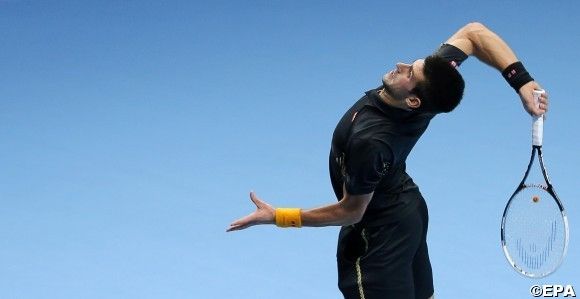Tennis Update – From Royal Tennis to Current Tennis
Early references to tennis — that is, to “court tennis” or “royal tennis” or “real tennis” — are few but intriguing. Many people will know of the alleged insult to King Henry V, in which the King of France supposedly sent tennis balls for the young Henry to play with.
From about the same time comes a reference by a Chancellor of Oxford, who wrote, “Sinners say nowadays, ‘I care not how many or what evils I do in God’s sight, for I can easily and quickly get plenary absolution and indulgence granted me by the Pope, whose written grant I have bought for 4d [four pence] or 6d [six pence] or have won as a stake for a game of tennis [with a pardoner].'” (Quoted in H. S. Bennett, Chaucer and the Fifteenth Century, being volume II, part 1 of the Oxford History of English Literature.)
Which, of course, has very little to do with modern tennis, or even the modern Catholic church. But it’s interesting to think about. The direct cost to a Pardoner of handing out one of his bogus Get-Out-of-Hell-Free certificates was slight (at most, parchment and ink, and perhaps not even that) — but there was the effort of processing the thing, plus it slightly devalued his other indulgences. So — unless the Pardoner involved was a gambling addict — he presumably thought he had a fair chance to win.
In other words, when the penitent beat the pardoner, it was an upset.
So, being us, we went from thinking about pardoners to thinking about upsets.
Our quick count is that there were 2593 losses recorded at the ATP level this year. (That’s not quite the same as the number of matches due to walkovers.) We show 832 of these as upsets — that is, as cases where a lower-ranked player beat a higher. That’s 32.1% of matches ending in upsets. Which means that the rankings are a lot better than random chance (in which case the upset rate would be 50%, give or take a little for statistical probability) — but it’s not .a great prediction rate.
On the other hand, we don’t really consider it much of an upset if, say, #80 beats #70. If #30 beats #1, that is an upset. (And in fact no such upset occurred in 2012; the worst loss by a #1 player was Novak Djokovic’s loss to #11 John Isner in the Indian Wells semifinal.) So we thought we’d take those 2593 matches and classify them based on “loss type.” For this purpose, we took the ratio of the loser’s rank to the winner’s rank and broke them up into groups. Remember, this is a ratio, so if #100 beats #10, that’s a 10:1 ratio, and if #10 beats #1, that’s also a 10:1 ratio, so they belong in the same group. After the number of results in a particular class, we show the percent of matches which fall in this group.
Extreme non-upsets: Loser’s rank at least 50 times worse than the winner’s rank: 35.(1.3%)
If it matters, the biggest non-upset of the year was #1 Djokovic’s win over #286 Devilder at Roland Garros.
Significant non-upsets: Loser’s rank at least 5 times the winner’s rank but less than 50 times the winner’s rank: 563.(21.7%)
Non-upsets: Loser’s rank at least 1.5 times the winner’s rank but less than 5 times the winner’s rank: 876.(33.8%)
Close non-upsets: Loser’s rank greater than or equal to the winner’s rank but less than 1.5 times the winner’s rank: 287.(11.1%)
Very minor upsets: Winner’s rank no greater than 1.2 times the loser’s rank: 124.(4.8%)
Minor upsets: Winner’s rank more than 1.2 times the but less than or equal to 1.5 times the loser’s rank: 142.(5.5%)
Upsets: Winner’s rank more than 1.5 times the loser’s but less than or equal to 5 times the loser’s: 470.(18.1%)
Significant upsets: Winner’s rank more than 5 times the loser’s but less than or equal to 10 times the loser’s: 57.(2.2%)
Very big upsets: Winner’s rank more than 10 times the loser’s but less than or equal to 20 times the loser’s: 30.(1.2%)
Huge upsets: Winner’s rank more than 20 times the loser’s: 9.(0.3%)
The biggest upset of the year, as you may recall from our earlier column on upsets, was #100 Rosol’s win over #2 Nadal at Wimbledon — a 50:1 ratio.
So although 32% of our matches were upsets (bad news for the Pardoner), only 3.7% were significant upsets, and only 1.5% were really big upsets. Maybe, if he were an ATP player and he carefully chose which matches to bet on, he could get away with betting after all.
At least as long as the anti-corruption people were looking the other way. But then, if they knew what Pardoners were like, they wouldn’t let them into the locker room….
©Daily Tennis News Wire
Topics: Atp, Court Tennis, early tennis, John Isner, Novak Djokovi, royal tennis, tennis funfacts, Tennis News


10sBalls Top Stories
- Reasons Behind the Increase in Sex Shops
- Reasons Behind the Increase in Sex Shops
- Reasons Behind the Increase in Sex Shops
- Casibom: Yaşayan Casinolar ve Bahisler Lider Platform
- Sea Star Casino: Play Games Without Registering Online
- JETZT DEN SWEET BONANZA SLOT GRATIS DREHEN
- Азартные игры с Мостбет Казино – испытайте удачу
- Çevrimiçi en iyi yuvalar: Hizmetinizde Karavan Bet Casino
- Top No Deposit Free Spins Offer for Canadians – December 2024
- Abe Bet Casino: Ücretsiz dönüşlerle heyecan hissedin
- Ünlü slotlar çevrimiçi kumarhanelerde başarı bet giriş ücretli formatta
- BasariBet Casino Giriş – En Güzel Canlı Casino Oyunlarına Katılın
- Игра на деньги в казино 1вин казино: безопасность
- De parking de credits sans oublier les Diction Casino Archive sauf que Perception
- Играть в хитовые слоты в надежных клубах azino777





 Tennis Update - From Royal Tennis to Current Tennis
Tennis Update - From Royal Tennis to Current Tennis